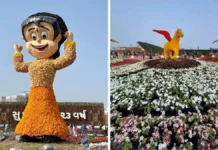LONDON: A new statue of Mahatma Gandhi, described as a gift to the UK city of Manchester, was unveiled amid fanfare on Friday. The 9-foot high, 800 kg bronze statue, created by well-known Indian artist Ram V Sutar, marks one of the tallest sculptures of the Father of the Nation outside India.
It is part of the Mahatma Gandhi Statue Project, an initiative of Shrimad Rajchandra Mission Dharampur UK (SRMD), a worldwide spiritual movement related Shrimad Rajchandraji Gandhi’s spiritual mentor.
The statue of Gandhi will celebrate the universal power of his message. A statue in Manchester will ensure that the heart of our politics and democracy can all be inspired with his ethos, SRMD UK said in a statement.
The group said that it had been inspired by the city’s unique civic pride which displayed the values of non-violence and compassion following the 2017 Islamic State claimed terrorist attack during a concert at Manchester Arena.
We are inspired by the people of Manchester for their strength, decency and community in the face of this unparalleled tragedy, the statement noted. The cost of the statue, installed outside Manchester Cathedral in the city’s Medieval Quarter, was sponsored by the Indian-origin Kamani Family in memory of their grandfather Bhanji Khanji Kamani.
The artist, Ram V Sutar, is the sculptor who designed the Statue of Unity, the world’s tallest sculpture, in Gujarat.
The project, supported by Manchester Cathedral, Manchester City Council, the Manchester India Partnership and the High Commission of India in London, marks part of ongoing initiatives across the UK to celebrate the 150th birth anniversary year of Mahatma Gandhi.
Sir Richard Leese, Leader of Manchester City Council, said: This statue of Mahatma Gandhi, a leader who tirelessly championed the power of peaceful protest, will find a welcome home in Manchester.
In the turbulent times we live in, his legacy of peace is one we can all appreciate and reflect on, he said.
The statue, the latest addition to a number of Gandhi statues across the UK, was planned considering the location, scale in the context of the space and ensuring there will be necessary pedestrian and disabled access, the organisers said.
Andrew Cowan, CEO of Manchester Airport and chair of the Manchester India Partnership, said: The unveiling of this statue is the latest example of the living bridge’ that exists between Greater Manchester and India. A huge amount of work has gone into forging closer ties between the two since the formation of the Manchester India Partnership 18 months ago.
It is a welcome addition to our city and is sure to prove popular with everyone who visits the city centre in the years ahead.
During a 1931 visit to the UK, Gandhi had visited the textile mills in Lancashire, travelling from London to Blackburn via Manchester, to meet with mill workers and explain the Indian perspective on the boycott of British goods that was damaging their Cottage industry.
During this visit, Gandhi attracted large crowds of admirers and received a warm welcome. The new sculpture harks back to that history and association between Gandhi and the city of Manchester.
There were some student groups who had protested against the statue with a Gandhi Must Fall campaign because of his well-documented anti-black racism and complicity in the British Empire’s actions in Africa .
The University of Manchester Students’ Union issued an open letter to Manchester City Council last month seeking a reconsideration of the decision.
However, the unveiling ceremony on Monday went ahead without incident, with invited guests including Andy Burnham, the Mayor of Greater Manchester, and senior figures from the High Commission of India in the UK, who were all welcomed by the head of SRMD UK, Pujya Gurudevshri Rakeshbhai. PTI







